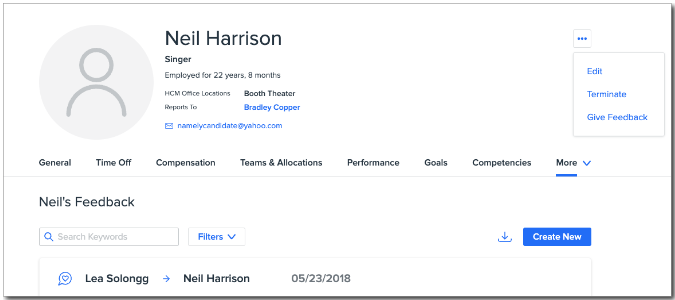Building a Culture of Continuous Feedback
Learn how to build a winning organizational culture with these best practices for implementing continuous feedback.
OVERVIEW
In a world where remote work is becoming the new normal—and where employees are seeking more opportunities for personal growth and professional support than ever before—building a culture of continuous feedback within your organization can elevate traditional performance management strategies.
Read on to learn how continuous feedback can help meet the evolving needs of today’s workplaces and provide a wealth of benefits to your organization and employees.
What Is Continuous Feedback?
At its most broad, continuous feedback refers to any feedback delivered regularly. Studies have shown that when employed as an HR strategy, continuous feedback can strengthen work relationships, increase employee engagement, offer real-time insights, enhance personal growth, and more.
How It Works
Namely’s Continuous Feedback feature streamlines the process of building a feedback culture in your organization. With this feature enabled:
-
Feedback can be exchanged outside of formal performance cycles—for example, at month-end or when a project is completed.
-
Our easy-to-navigate Feedback tab allows feedback to be shared between employees and managers, as well as from peer to peer.
-
Employees receive notifications instantly when they receive feedback, and Namely saves feedback on their profile for future review.
-
Our Note to Self feature lets employees store in-the-moment performance notes that only they can view, making it easier to offer detailed feedback during later performance conversations and reviews.
-
Additionally, administrators can configure visibility settings, customize instructions, and create topics that categorize feedback for easy filtering and reporting.

Benefits
Namely’s Continuous Feedback offers your entire organization a wealth of benefits, including:
Real-Time Insights
-
Reduce the traditional lag-time between formal performance reviews with more frequent conversations.
-
Managers can quickly clarify expectations before a colleague works too far ahead in a project, helping employees more effectively complete short-term objectives.
Employee Empowerment
-
Employee-to-manager feedback encourages two-way communication and empowers employees to bring valuable insights to the company, allowing managers to gauge employee satisfaction more effectively.
-
Frequent check-ins around performance, progress, and growth opportunities support employees in achieving long-term goals.
Open Communication
-
Peer-to-peer feedback encourages open communication and strengthens working relationships, and private suggestions provide space to cultivate honesty and openness.
Stored Information
-
Store performance notes about yourself or colleagues throughout the year for easy reference later during review cycles or if performance concerns arise.
Solutions for Remote Work
-
As new work environments include less in-person interaction, employees often don’t receive as much informal feedback as they have in the past. Continuous feedback can encourage employees & managers to have more frequent development conversations.
RECOMMENDATIONS
Organizational change is rarely straightforward. If your company currently operates under a traditional performance review structure, the prospect of introducing new performance management strategies into your organization might seem overwhelming. That’s exactly why Namely has developed our Continuous Feedback tool, which—along with the best practices in this guide—can help your organization seamlessly integrate feedback culture into your work.
As you leverage continuous feedback within your company, here are our recommendations on how to best take advantage of this feature:
Supplement Performance Reviews
We recommend that your organization use continuous feedback in addition to existing performance reviews rather than in place of them. Remember that engaging in more frequent development conversations can increase employee engagement and productivity. In addition, referencing past feedback and notes to self when it comes time for formal performance cycles will also help enable more accurate and unbiased suggestions for improvement.
Share Expectations
When using Namely’s Continuous Feedback tool, we recommend you articulate organizational expectations for how employees should share feedback. Additionally, let employees know your guidelines on when they should use the Appreciations feature on the company newsfeed instead of sharing feedback privately.
In addition to clearly outlining expectations for employees, ensure you’ve clearly documented your company’s plan for building a feedback culture, just as you would with any other performance management process.
Read How to Build a Feedback Culture on the Namely Blog for helpful insights on incorporating ongoing feedback within your organization.
Encourage Frequent Feedback
Regularly sharing feedback helps foster proactive communication and ongoing improvement, so be sure you’re encouraging your employees to share feedback frequently. Offer regular reminders to colleagues that they should give feedback whenever they see someone doing something exceptional. You can also consider company-wide incentives to get employees in the habit.
If you need guidance on how to encourage your employees to give feedback, we’ve prepared some language you can post to your company newsfeed to get your staff started:
#Give Your Coworkers Some Feedback!
Did one of your co-workers go above and beyond recently? Do you have some suggestions for how a teammate can improve their performance? Now you can privately share your feedback with your colleagues and their managers using Namely’s new Continuous Feedback feature.
The key factor to delivering effective feedback is to make sure your feedback is constructive, not critical. That means it should be goal-oriented, transparent, and direct. Ask yourself, if I received this feedback, what would be my takeaway? Would I know what to do? Be empathetic and offer support on how your coworker can apply the feedback you’re giving.
Feedback can be given at any time—there’s no need to wait for a performance review. By providing regular comments to your workers on their performance and contributions, you’ll help foster a culture of communication and growth.
Ready to get started? Review Namely’s Guide to Providing Feedback—it walks you through what makes for good, effective feedback, and also provides instructions on how to give feedback in Namely.
Help us build a culture of feedback at [Insert Company Name]. Start giving your colleagues feedback today!
LEARN MORE
For information on configuring and customizing your organization’s Continuous Feedback settings, see our article Configuring Continuous Feedback.